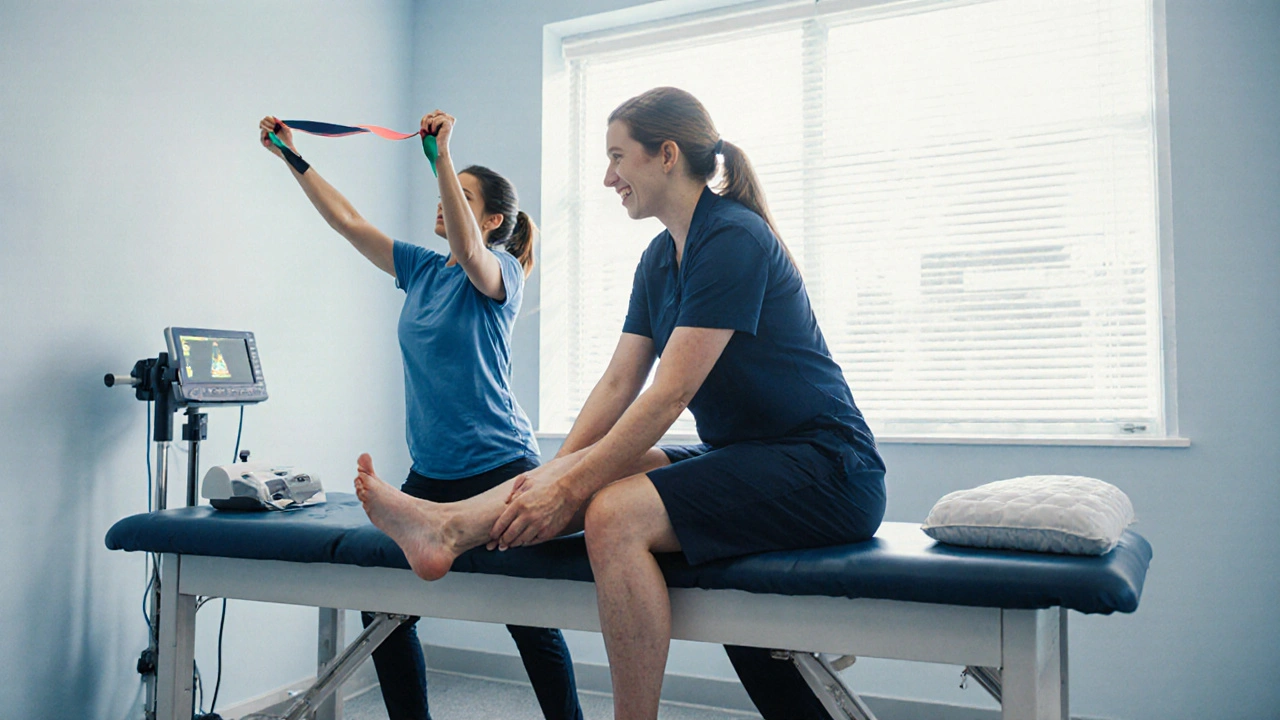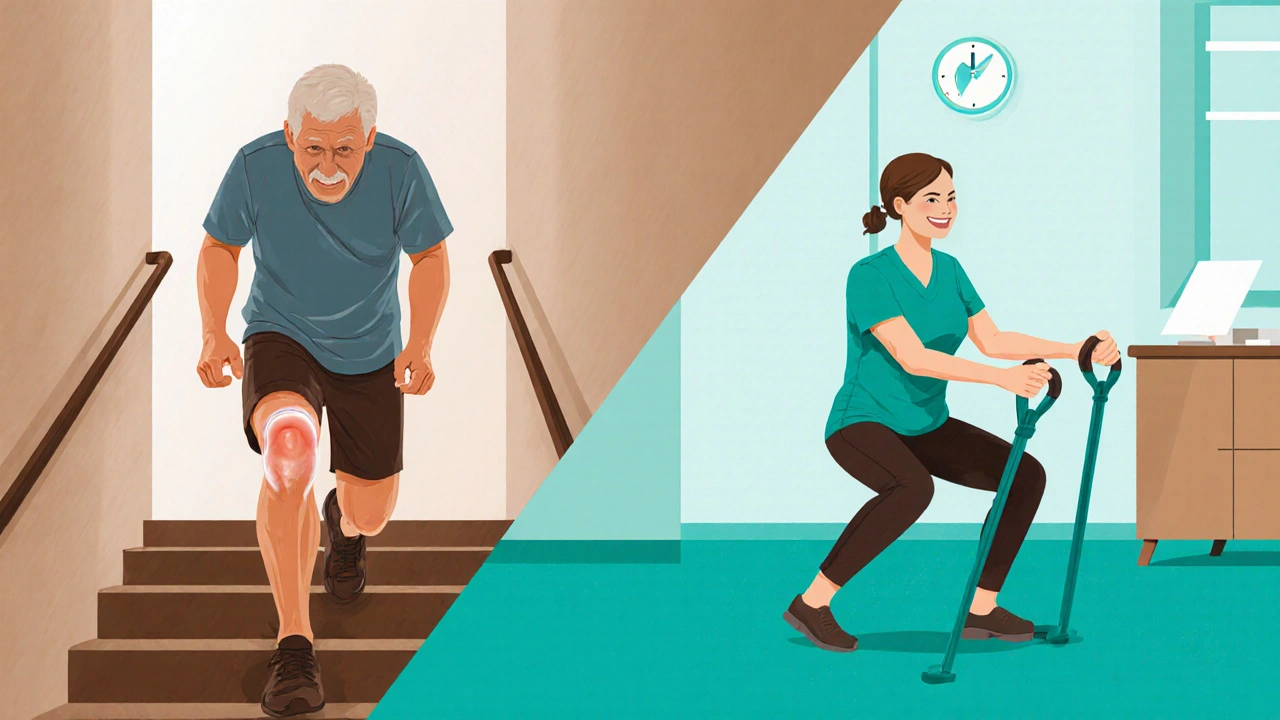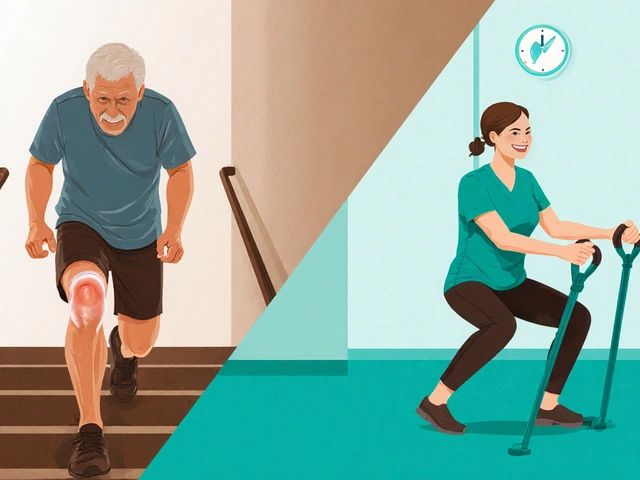Joint Rehab Walking Distance Estimator
How Physical Therapy Improves Mobility
Based on a 2023 study of knee osteoarthritis patients, a 12-week physical therapy program can increase walking distance by 35%. Enter your current walking distance to estimate potential improvement.
Joint pain can turn everyday tasks into chores, and many wonder how to get back to normal without surgery. Physical therapy is a clinical service that blends exercise, manual techniques, and therapeutic modalities to restore movement and reduce pain. When you pair it with a focused rehabilitation plan, the chances of regaining full function rise dramatically. Below we break down why physical therapy is a go‑to option for anyone dealing with joint damage.
Understanding Joint Damage
Joint damage refers to any injury or degeneration that compromises the cartilage, ligaments, meniscus, or bone surfaces that make a joint work smoothly. Common culprits include sports sprains, osteoarthritis, rheumatoid arthritis, and post‑surgical wear. Damage often shows up as swelling, limited range of motion, and sharp or dull pain during everyday activities.
How Physical Therapy Helps
The magic of physical therapy lies in its ability to address the root causes of joint dysfunction. A physical therapist is a licensed health professional trained to assess movement patterns and prescribe tailored interventions. By combining assessment data with evidence‑based protocols, therapists guide the body back to optimal mechanics.
Core Techniques Used in Joint Rehab
- Exercise therapy focuses on strengthening, stretching, and conditioning the muscles around the joint. Strong muscles support the joint, offload stress, and improve stability.
- Manual therapy includes hands‑on mobilizations, soft‑tissue massage, and joint manipulations to improve tissue elasticity and joint glide.
- Therapeutic modalities such as ultrasound, electrical stimulation, and cold/heat packs that reduce inflammation and prepare tissues for active work.
- Range‑of‑motion (ROM) exercises target the joint’s movement limits, helping to restore flexibility and prevent contractures.

Evidence‑Backed Benefits
Research consistently shows that structured physical therapy programs cut pain scores by 40‑60% and improve functional scores by a similar margin. A 2023 randomized trial on knee osteoarthritis found that participants who completed a 12‑week PT protocol showed a 35% increase in walking distance compared to a control group that relied solely on medication.
Key benefits include:
- Reduced reliance on opioids and NSAIDs.
- Improved joint stability, lowering the risk of future injuries.
- Enhanced proprioception, which helps prevent falls.
- Faster return to work or sport.
- Long‑term preservation of joint health, delaying the need for joint replacement.
Who Should Consider Physical Therapy?
Physical therapy isn’t just for athletes. It’s ideal for anyone experiencing:
- Persistent joint pain that hasn’t responded to rest or medication.
- Post‑surgical stiffness after procedures like meniscus repair or total knee replacement.
- Limited mobility that hampers daily tasks such as climbing stairs or dressing.
- Swelling or inflammation that recurs after activity.
Even mild cartilage wear can benefit from early intervention, because strengthening surrounding muscles often stalls degeneration.
What to Expect in a Rehabilitation Program
- Initial Assessment: The therapist evaluates posture, gait, strength, ROM, and pain triggers.
- Goal Setting: Together you set realistic milestones (e.g., “walk 500m without pain”).
- Treatment Phase: A mix of the core techniques listed above, personalized to your injury and goals.
- Home Exercise Program: Therapists prescribe daily drills you’ll continue outside the clinic.
- Progress Review: Every 2‑4 weeks the therapist measures improvements and tweaks the plan.
Typical programs last 6‑12 weeks, but many patients maintain benefits with a minimal maintenance routine after the intensive phase.

Choosing the Right Physical Therapist
Not all therapists specialize in joint rehabilitation. Look for these credentials:
- Board‑certified orthopedic clinical specialist (OCS) or sports clinical specialist (SCS).
- Experience treating the specific joint you’re concerned with (knee, hip, shoulder, etc.).
- Familiarity with evidence‑based protocols such as the McKenzie method or the GRADE‑B protocol for osteoarthritis.
- Positive patient testimonials regarding pain reduction and functional gains.
| Technique | Main Goal | Typical Session Duration | Key Outcome |
|---|---|---|---|
| Exercise Therapy | Strength & endurance | 30‑45min | Improved load‑bearing capacity |
| Manual Therapy | Joint glide & tissue flexibility | 15‑30min | Increased ROM, reduced stiffness |
| Therapeutic Modalities | Pain control & inflammation reduction | 10‑20min | Faster activation of exercises |
Practical Tips to Maximize Results
- Stay consistent - missing sessions can stall progress.
- Log pain levels before and after each session; trends guide adjustments.
- Combine PT with a joint‑friendly diet rich in omega‑3s and vitaminD.
- Use supportive footwear or braces as advised, especially during early phases.
- Communicate openly with your therapist about any setbacks.
Frequently Asked Questions
How soon can I start physical therapy after a joint injury?
Most clinicians recommend beginning PT within the first week after injury, once the acute swelling is under control. Early movement helps prevent scar tissue and maintains muscle activation.
Will physical therapy eliminate all joint pain?
PT can dramatically lower pain levels, but chronic conditions like advanced osteoarthritis may still cause occasional discomfort. The goal is to improve function and reduce pain to a manageable level.
Do I need special equipment at home?
Most programs use body‑weight, resistance bands, and a sturdy chair. Your therapist will prescribe a simple kit that fits in a small space.
Is physical therapy covered by insurance?
In many countries, including NewZealand, public health plans and private insurers cover a set number of PT sessions for joint injuries when a doctor’s referral is provided.
Can I combine physical therapy with other treatments?
Absolutely. PT often works alongside medication, injections, or surgical interventions to boost overall outcomes. Always discuss a combined plan with your healthcare team.

